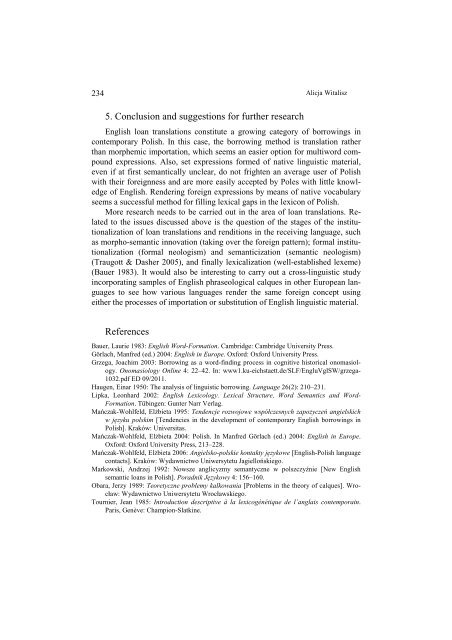s - Wyższa SzkoÅa Filologiczna we WrocÅawiu
s - Wyższa SzkoÅa Filologiczna we WrocÅawiu
s - Wyższa SzkoÅa Filologiczna we WrocÅawiu
You also want an ePaper? Increase the reach of your titles
YUMPU automatically turns print PDFs into web optimized ePapers that Google loves.
234<br />
Alicja Witalisz<br />
5. Conclusion and suggestions for further research<br />
English loan translations constitute a growing category of borrowings in<br />
contemporary Polish. In this case, the borrowing method is translation rather<br />
than morphemic importation, which seems an easier option for multiword compound<br />
expressions. Also, set expressions formed of native linguistic material,<br />
even if at first semantically unclear, do not frighten an average user of Polish<br />
with their foreignness and are more easily accepted by Poles with little knowledge<br />
of English. Rendering foreign expressions by means of native vocabulary<br />
seems a successful method for filling lexical gaps in the lexicon of Polish.<br />
More research needs to be carried out in the area of loan translations. Related<br />
to the issues discussed above is the question of the stages of the institutionalization<br />
of loan translations and renditions in the receiving language, such<br />
as morpho-semantic innovation (taking over the foreign pattern); formal institutionalization<br />
(formal neologism) and semanticization (semantic neologism)<br />
(Traugott & Dasher 2005), and finally lexicalization (<strong>we</strong>ll-established lexeme)<br />
(Bauer 1983). It would also be interesting to carry out a cross-linguistic study<br />
incorporating samples of English phraseological calques in other European languages<br />
to see how various languages render the same foreign concept using<br />
either the processes of importation or substitution of English linguistic material.<br />
References<br />
Bauer, Laurie 1983: English Word-Formation. Cambridge: Cambridge University Press.<br />
Görlach, Manfred (ed.) 2004: English in Europe. Oxford: Oxford University Press.<br />
Grzega, Joachim 2003: Borrowing as a word-finding process in cognitive historical onomasiology.<br />
Onomasiology Online 4: 22–42. In: www1.ku-eichstaett.de/SLF/EngluVglSW/grzega-<br />
1032.pdf ED 09/2011.<br />
Haugen, Einar 1950: The analysis of linguistic borrowing. Language 26(2): 210–231.<br />
Lipka, Leonhard 2002: English Lexicology. Lexical Structure, Word Semantics and Word-<br />
Formation. Tübingen: Gunter Narr Verlag.<br />
Mańczak-Wohlfeld, Elżbieta 1995: Tendencje rozwojo<strong>we</strong> współczesnych zapożyczeń angielskich<br />
w języku polskim [Tendencies in the development of contemporary English borrowings in<br />
Polish]. Kraków: Universitas.<br />
Mańczak-Wohlfeld, Elżbieta 2004: Polish. In Manfred Görlach (ed.) 2004: English in Europe.<br />
Oxford: Oxford University Press, 213–228.<br />
Mańczak-Wohlfeld, Elżbieta 2006: Angielsko-polskie kontakty języko<strong>we</strong> [English-Polish language<br />
contacts]. Kraków: Wydawnictwo Uni<strong>we</strong>rsytetu Jagiellońskiego.<br />
Markowski, Andrzej 1992: Nowsze anglicyzmy semantyczne w polszczyźnie [New English<br />
semantic loans in Polish]. Poradnik Językowy 4: 156–160.<br />
Obara, Jerzy 1989: Teoretyczne problemy kalkowania [Problems in the theory of calques]. Wrocław:<br />
Wydawnictwo Uni<strong>we</strong>rsytetu Wrocławskiego.<br />
Tournier, Jean 1985: Introduction descriptive à la lexicogénétique de l’anglais contemporain.<br />
Paris, Genève: Champion-Slatkine.
















